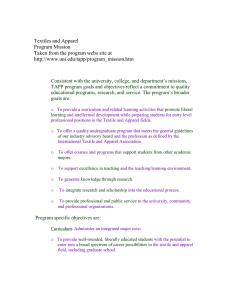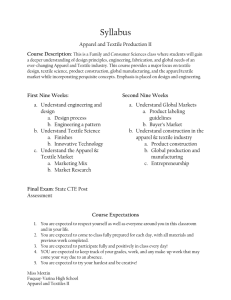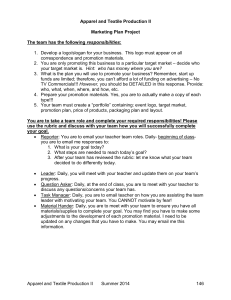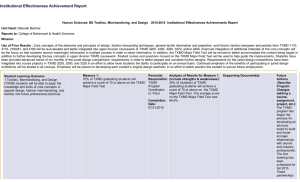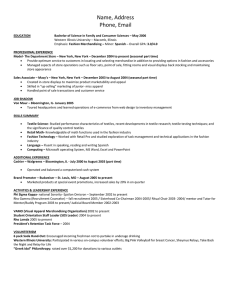Fashion Merchandising Standards
advertisement
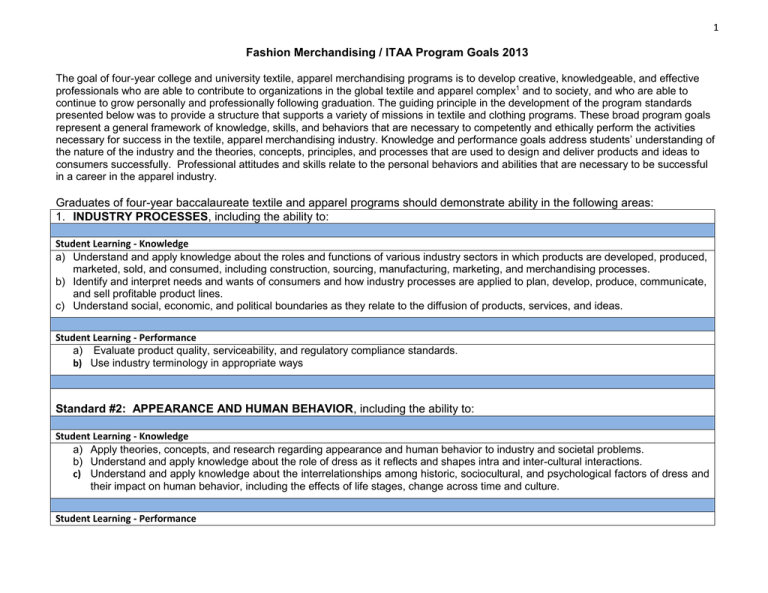
1 Fashion Merchandising / ITAA Program Goals 2013 The goal of four-year college and university textile, apparel merchandising programs is to develop creative, knowledgeable, and effective professionals who are able to contribute to organizations in the global textile and apparel complex1 and to society, and who are able to continue to grow personally and professionally following graduation. The guiding principle in the development of the program standards presented below was to provide a structure that supports a variety of missions in textile and clothing programs. These broad program goals represent a general framework of knowledge, skills, and behaviors that are necessary to competently and ethically perform the activities necessary for success in the textile, apparel merchandising industry. Knowledge and performance goals address students’ understanding of the nature of the industry and the theories, concepts, principles, and processes that are used to design and deliver products and ideas to consumers successfully. Professional attitudes and skills relate to the personal behaviors and abilities that are necessary to be successful in a career in the apparel industry. Graduates of four-year baccalaureate textile and apparel programs should demonstrate ability in the following areas: 1. INDUSTRY PROCESSES, including the ability to: Student Learning - Knowledge a) Understand and apply knowledge about the roles and functions of various industry sectors in which products are developed, produced, marketed, sold, and consumed, including construction, sourcing, manufacturing, marketing, and merchandising processes. b) Identify and interpret needs and wants of consumers and how industry processes are applied to plan, develop, produce, communicate, and sell profitable product lines. c) Understand social, economic, and political boundaries as they relate to the diffusion of products, services, and ideas. Student Learning - Performance a) Evaluate product quality, serviceability, and regulatory compliance standards. b) Use industry terminology in appropriate ways Standard #2: APPEARANCE AND HUMAN BEHAVIOR, including the ability to: Student Learning - Knowledge a) Apply theories, concepts, and research regarding appearance and human behavior to industry and societal problems. b) Understand and apply knowledge about the role of dress as it reflects and shapes intra and inter-cultural interactions. c) Understand and apply knowledge about the interrelationships among historic, sociocultural, and psychological factors of dress and their impact on human behavior, including the effects of life stages, change across time and culture. Student Learning - Performance 2 Standard #3: AESTHETICS AND THE DESIGN PROCESS, including the ability to: Student Learning - Knowledge a) Understand and apply knowledge about aesthetics and the design process in relation to dress and appearance management. b) Understand how aesthetics and the design process can support quality of life, social responsibility, and sustainability c) Understand the role of historical, socio-cultural, and psychological factors in aesthetic expression. Student Learning - Performance a) Use the design process to create products that meet marketplace needs. b) Relate the elements and principles of design to product development, use, and evaluation. Standard #4: GLOBAL INTERDEPENDENCE, including the ability to: Student Learning - Knowledge a) Understand how dynamic and diverse political, cultural, and economic systems impact industry processes. b) Understand how theoretical perspectives on markets, trade, and economic development can be applied to historical and current data on production, consumption, and disposal of products. Student Learning - Performance PROFESSIONAL ATTITUDES AND SKILLS 1. Standard #5: ETHICS, SOCIAL RESPONSIBILITY, AND SUSTAINABILITY, including the ability to: Student Learning - Knowledge a) Identify and evaluate issues of social responsibility, professional behavior, and ethics related to the impact of individual, organizational, and corporate decision making. b) Analyze and evaluate issues related to environmental sustainability and environmental impact as they relate to industry activities and processes. Student Learning - Performance 3 Standard #6: CRITICAL AND CREATIVE THINKING, including the ability to: Student Learning - Knowledge a) Demonstrate critical and creative thinking skills, including the ability to critically evaluate and compare diverse perspectives. b) Identify and understand social, cultural, economic, technological, ethical, political, educational, language, and individual influences on industry issues. Student Learning - Performance a) Apply quantitative and qualitative skills to problem solving within the textile and apparel complex. b) Apply quantitative and qualitative skills to problem solving within the textile and apparel complex. c) Use appropriate technology to facilitate critical, creative, quantitative, and qualitative thinking within the textile and apparel complex. a. Standard #7: PROFESSIONAL DEVELOPMENT, including the ability to: Student Learning - Knowledge a) Identify and evaluate issues of social responsibility, professional behavior, and ethics related to the impact of individual, organizational, and corporate decision making. b) Analyze and evaluate issues related to environmental sustainability and environmental impact as they relate to industry activities and processes. Student Learning - Performance a) Communicate ideas in written, oral, and visual forms using appropriate technology. b) Function as team members and leaders within professional and culturally diverse environments. c) Demonstrate the ability to critique one self and others constructively. d) Apply career planning concepts and job search strategies to the diverse industry opportunities. 4 1 Global Textile and Apparel Complex is defined as the interaction of the design, product development, and merchandising processes, to retail organizational structures and formats, and to channels of distribution in a global market place. b. Standard #7: TEXTILES, including the ability to: Student Learning - Knowledge a) To describe the role of textiles in product development b) To recognize how textile apparel, interior, and technical products enhance quality of life c) Explain why fibers are engineered for specific end uses d) To differentiate among special-use fibers based on their elastomeric or protective characteristics e) To recognize the importance of these fibers in apparel, interiors, and technical products f) g) h) i) j) To integrate properties of special-use fibers with their uses To name basic woven fabrics Understand the general steps and sequence involved in fabric finishing Relate cleaning and storage to product serviceability and consumer satisfaction To understand the importance of developing a professional knowledge of textiles k) l) m) n) o) p) q) To recognize how textiles, as apparel, furnishings, and industrial products, contribute to contemporary life To recognize the need to communicate textiles information quickly and accurately to other professionals and consumers To understand environmental concerns and sustainability concepts related to the global textile complex To understand terms describing textile fibers and their properties To understand the global nature of the textile complex Describe the process of manufacturing fibers Identify the differences and similarities among natural and manufactured fibers Student Learning - Performance - 5 Standard #8: Buying, including the ability to: Student Learning - Knowledge a) Understand the buyer’s role in traditional retailing operations such as department stores, chains, and single-unit independent stores b) Identify the different types of retail organizations that comprise the traditional classification c) Understand the primary merchandising philosophy of the various merchandising operations including: retail discount operations, internet, specialty, anchor, and wholesale. d) Demonstrate knowledge of the contemporary design and designers and how those designs are represented through retail outlets accessible to the general public. e) f) Understand the term demographics and the role they play in providing information to the researcher g) Identify the different lifespan periods and family life cycle classifications and how each approaches their purchasing needs h) Define the following terms and discuss how they affect purchase orders: anticipation, trade discounts, seasonal discounts, advertising allowances, and postdating i) Understand the mathematics involved in markup at retail, cost, related problems, cumulative markup, average markup, markdown percent, and turnover j) Define price points and discuss five advantages of their use k) Discuss the ever-growing concept often referred to as The Store Is the Brand l) Define the term visual merchandising Student Learning - Performance d)
